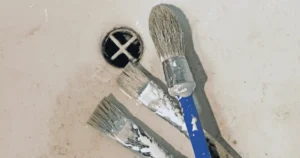Call us: (863) 983-8465
Top 10 Hacks for Cleaning Oil Paint Brushes

To clean oil paint brushes, first, wipe off excess paint using a paper towel or rag. Then, dip the brush into a container of solvent, such as turpentine or mineral spirits, and gently work it through the bristles. Once the paint is mostly removed, rinse the brush in warm, soapy water to remove the solvent. Once you’re done, carefully reshape the brush bristles to their original form and let it dry completely before putting it away.
Best Solvent for Cleaning Oil Paint Brushes
Mineral Spirits
Clean Brush with Mineral spirits is the most commonly used solvent for cleaning oil paint brushes. They effectively dissolve oil paints and are gentler on the bristles, making them a popular choice for brush care.
Turpentine
Turpentine is another solvent that works well for cleaning brushes, though it has a stronger odor and is more potent. It can be effective in removing stubborn paint but may be harsher on the brushes.
Other Solvents
There are other alternatives like citrus-based cleaners and specialized brush cleaners, which are often less toxic and have a more pleasant scent, but mineral spirits and turpentine remain the top choices.
How to Clean Oil Paint Brushes

Step1: Remove Excess Paint
Wipe off as much oil paint as possible using a paper towel or rag. Gently press the brush against the surface to remove excess paint before cleaning.
Step2: Dip the Brush in Solvent
Pour a small amount of solvent, such as mineral spirits or turpentine, into a container. Place the brush in the solvent and gently move it through the bristles to help break down the paint.
Step3: Scrub the Bristles
Use a brush comb or fingers to work solvent through the bristles, removing all paint. Repeat until the brush is completely clean.
Step4: Rinse with Soapy Water
After most of the paint is removed, rinse the brush in warm, soapy water to remove the solvent. Use mild dish soap to clean the bristles thoroughly.
Step5: Shape the Brush
Once clean, reshape the bristles with your fingers or by gently combing through them to keep them in good condition.
Step6: Dry the Brush
Lay the brush flat on a clean towel or hang it upside down to dry completely. Avoid storing the brush with wet bristles to prevent damage.
Cleaning Brushes for Different Types of Oil Paints

| Type of Oil Paint | Cleaning Tips |
|---|---|
| Thick Paints | Use a solvent like turpentine or mineral spirits to break down the thick paint. Let the brush soak longer in the solvent to help dissolve and remove stubborn paint more effectively. |
| Thin Paints (e.g., Washes) | Use a milder solvent like citrus-based cleaners or soap and water. Clean the brush right away to prevent paint from drying and hardening in the bristles. |
| Enamel Paint | Use a stronger solvent like white spirits or acetone for quicker removal of enamel. Rinse thoroughly. |
| Fast-Drying Paint | Clean brushes quickly to prevent paint from drying and hardening in the bristles. Use solvents or soap depending on the type. |
How to Remove Paint From Hard-to-Clean Brushes

How to Clean Dried Oil Paint Brushes

- Soak the brush in solvent (like mineral spirits or turpentine) for a few hours or overnight.
- Gently work the bristles with your fingers or a brush comb to remove loosened paint.
- Wash the brush with warm, soapy water to remove any remaining paint and solvent.
- Use a palette knife to gently scrape off any tough paint.
- Rinse the brush thoroughly, reshape the bristles, and let it dry completely.
How to Clean Shaving Brush

To clean a shaving brush, rinse it under warm water after use to remove shaving cream or soap. If needed, lather it with mild soap or shampoo and gently work it through the bristles. Rinse it again until the soap is completely washed out. After cleaning, gently shake off excess water and let the brush air dry with bristles pointing downward. Store the brush in a dry place to keep it in good condition.
Common Mistakes to Avoid When Cleaning Your Shaving Brush
- Using hot water can damage the bristles. Always use lukewarm water instead.
- Failing to rinse the brush thoroughly can leave shaving cream or soap residue. Make sure to rinse it completely.
- Harsh chemicals or strong soaps can damage the bristles, so avoid using them. Stick to mild cleansers.
- Avoid scrubbing too hard, as this can damage the bristles and reduce the brush’s lifespan.
- Not shaking out excess water can cause moisture to stay in the brush, leading to mold. Shake it well after rinsing.
- Storing the brush while it’s still wet can cause mildew or mold growth, so always let it dry completely.
- Storing the brush with the bristles facing up can cause water to accumulate in the handle. Store it with bristles facing down.
Final Thoughts
Properly cleaning your oil paint brushes is key to maintaining their performance and prolonging their lifespan. By following the right steps—wiping off excess paint, using a suitable solvent, and thoroughly cleaning with soapy water—you can keep your brushes in top shape. Always reshape and dry your brushes carefully to ensure they are ready for your next painting session.
FAQS
How to Clean Watercolor Brushes?
Rinse the brush with warm water, then gently wash with soap if needed. Reshape the bristles and let it dry.
How to Clean a Shoe Polish Brush?
Tap off excess polish, rinse with warm water, and use soap if necessary. Let it dry completely.
How to Clean a Horsehair Brush?
Rinse with warm water, use mild soap if needed, and avoid soaking. Reshape the bristles and let it dry.
How Often Should I Clean My Brushes?
Clean brushes after each use to maintain their shape and performance.




